Related Research Articles

Charles John Huffam Dickens was an English writer and social critic. He created some of the world's best-known fictional characters and is regarded by many as the greatest novelist of the Victorian era. His works enjoyed unprecedented popularity during his lifetime and, by the 20th century, critics and scholars had recognised him as a literary genius. His novels and short stories are widely read today.
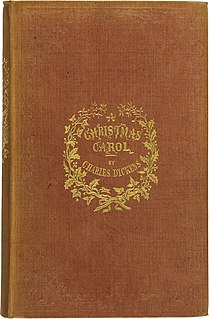
A Christmas Carol. In Prose. Being a Ghost Story of Christmas, commonly known as A Christmas Carol, is a novella by Charles Dickens, first published in London by Chapman & Hall in 1843 and illustrated by John Leech. A Christmas Carol recounts the story of Ebenezer Scrooge, an elderly miser who is visited by the ghost of his former business partner Jacob Marley and the spirits of Christmas Past, Present and Yet to Come. After their visits, Scrooge is transformed into a kinder, gentler man.

Great Expectations is the thirteenth novel by Charles Dickens and his penultimate completed novel. It depicts the education of an orphan nicknamed Pip. It is Dickens' second novel, after David Copperfield, to be fully narrated in the first person. The novel was first published as a serial in Dickens's weekly periodical All the Year Round, from 1 December 1860 to August 1861. In October 1861, Chapman and Hall published the novel in three volumes.

Miss Havisham is a character in the Charles Dickens novel Great Expectations (1861). She is a wealthy spinster, once jilted at the altar, who insists on wearing her wedding dress for the rest of her life. She lives in a ruined mansion with her adopted daughter, Estella. Dickens describes her as looking like "the witch of the place".
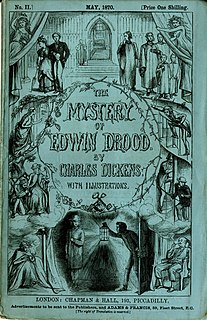
The Mystery of Edwin Drood is the final novel by Charles Dickens, originally published in 1870.
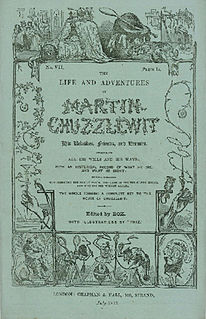
The Life and Adventures of Martin Chuzzlewit is a novel by Charles Dickens, considered the last of his picaresque novels. It was originally serialised between 1842 and 1844. While he was writing it Dickens told a friend that he thought it was his best work thus far, but it was one of his least popular novels, judged by sales of the monthly instalments. Characters in this novel gained fame, including Pecksniff and Mrs Gamp.
Constantia is a South African dessert wine. It is made from Muscat Blanc à Petits Grains grapes grown in the district of Constantia, City of Cape Town. In the eighteenth and nineteenth centuries it was widely exported to Europe. However, production of Constantia ceased in the late nineteenth century following the devastation of South African vineyards by the phylloxera epidemic. Production resumed at Klein Constantia in 1986, at Groot Constantia in 2003 and at Buitenverwachting in 2007.

Ellen Lawless Ternan, also known as Nelly Ternan or Nelly Wharton-Robinson, was an English actress known for association with the author Charles Dickens.
The sensation novel, also sensation fiction, was a literary genre of fiction that achieved peak popularity in Great Britain in the 1860s and 1870s. Its literary forebears included the melodramatic novels and the Newgate novels, which focused on tales woven around criminal biographies; it also drew on the Gothic, romance, as well as mass market genres. The genre's popularity was conjoined to an expanding book market and growth of a reading public, by-products of the Industrial Revolution. Whereas romance and realism had traditionally been contradictory modes of literature, they were brought together in sensation fiction. The sensation novelists commonly wrote stories that were allegorical and abstract; the abstract nature of the stories gave the authors room to explore scenarios that wrestled with the social anxieties of the Victorian era. The loss of identity is seen in many sensation fiction stories because this was a common social anxiety; in Britain, there was an increased use in record keeping and therefore people questioned the meaning and permanence of identity. The social anxiety regarding identity is reflected in novels such as The Woman in White and Lady Audley's Secret.

Abel Magwitch is a major fictional character from Charles Dickens' 1861 novel Great Expectations.
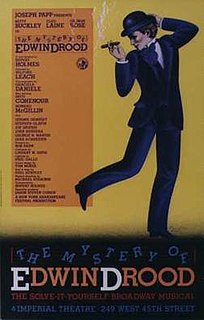
The Mystery of Edwin Drood is a musical based on the unfinished Charles Dickens novel. Written by Rupert Holmes, the show was the first ever Broadway musical with multiple endings. The musical won five Tony Awards out of eleven nominations, including Best Musical. Holmes received Tony awards for Best Book of a Musical and Best Original Score.

Martin Chuzzlewit is a 1994 TV serial produced by the BBC, based on the 1844 novel by Charles Dickens, with a screenplay by David Lodge and directed by Pedr James. The music was composed by Geoffrey Burgon.
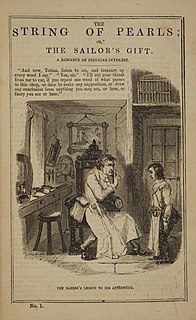
The String of Pearls: A Domestic Romance is a fictional story first published as a penny dreadful serial from 1846–47. The main antagonist of the story is Sweeney Todd, "the Demon Barber of Fleet Street". The story was the character's first literary appearance.

The Last Dickens is a novel by Matthew Pearl published by Random House. It is a work of historical and literary fiction. The novel is a Washington Post Critics' Pick. It contains some characters from The Dante Club.

Joseph Clayton Clark, who worked under the pseudonym "Kyd", was a British artist best known for his illustrations of characters from the novels of Charles Dickens. The artwork was published in magazines or sold as watercolor paintings, rather than included in an edition of the novels.

Dickensian is a British drama television series that premiered on BBC One from 26 December 2015 to 21 February 2016. The 20-part series, created and co-written by Tony Jordan, brings characters from many Charles Dickens novels together in one Victorian London neighbourhood, as Inspector Bucket investigates the murder of Ebenezer Scrooge's partner Jacob Marley.

Mary Scott Hogarth was the sister of Catherine Dickens and the sister-in-law of Charles Dickens. Hogarth first met Charles Dickens at age 14, and after Dickens married Hogarth's sister Catherine, Mary lived with the couple for a year. Hogarth died suddenly in 1837, which caused Dickens to miss the publication dates for two novels: The Pickwick Papers and Oliver Twist. Hogarth later became the inspiration for a number of characters in Dickens novels, including Rose Maylie in Oliver Twist and Little Nell in The Old Curiosity Shop. Charles and Catherine Dickens' first daughter was named Mary in her memory.
Nicola Anne Lulham Bradbury D. Phil. is an English literary critic, lecturer, editor, and author, specializing in the 19th century novel.
Madeline House was a British scholar of English literature, a specialist in the works of Charles Dickens, and known for her editorship of the Pilgrim edition of his letters. She was a winner of the British Academy's Rose Mary Crawshay Prize in 1965.
References
- 1 2 3 Horrocks, Sarah (15 March 2011). "Margaret Cardwell obituary". The Guardian . Retrieved 4 May 2021.
- ↑ Rosenberg, Edgar (1974). "Restoration in Cloisterham: The "Clarendon Drood"". Dickens Studies Newsletter. 5 (3). JSTOR 45290430.
- ↑ Monod, Sylvère (1984). "Martin Chuzzlewit by Charles Dickens, Margaret Cardwell". The Modern Language Review. 79 (1). JSTOR 3730340.
- ↑ Brattin, Joel J. (1994). "Great Expectations. The Clarendon Dickens by Charles Dickens, Margaret Cardwell". Dickens Quarterly. 11 (3). JSTOR 45291507.